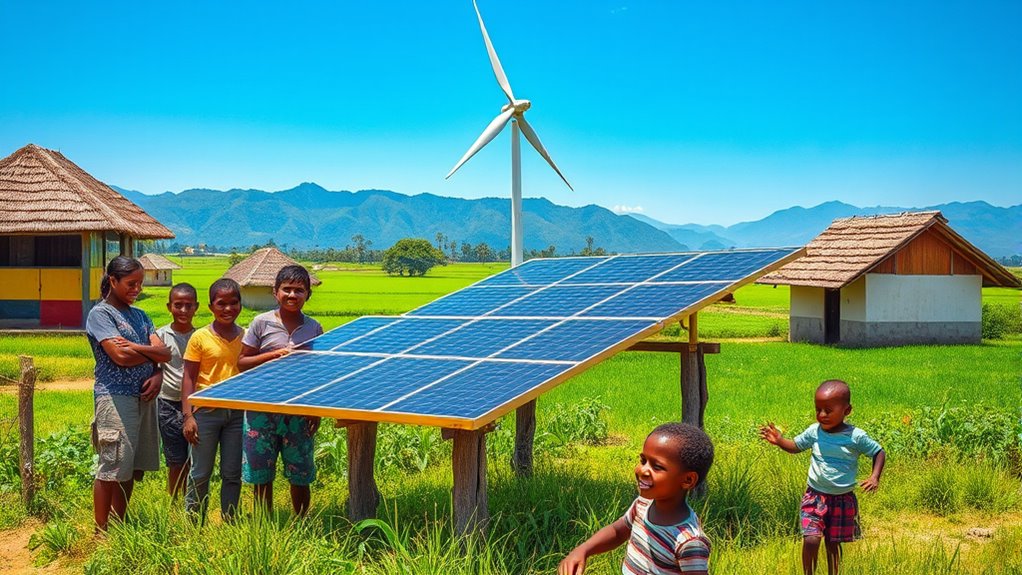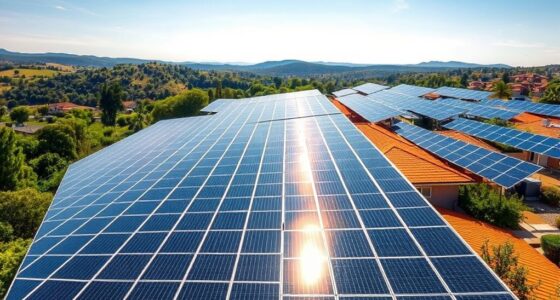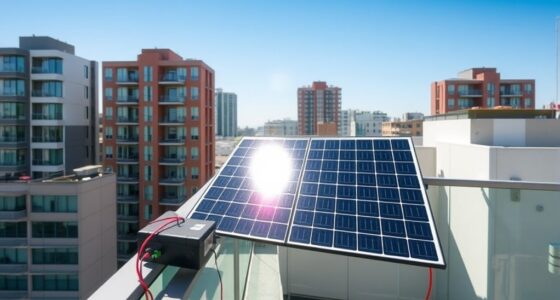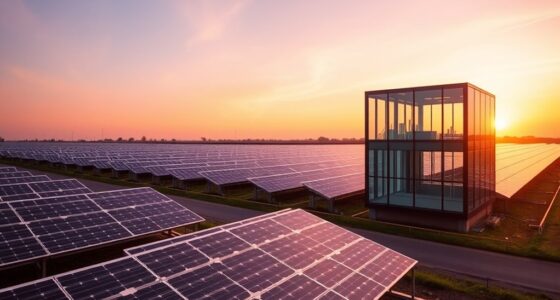Renewables in the developing world empower communities by providing affordable, reliable energy closer to where it’s needed most. Solar microgrids and wind turbines enable local power generation, reducing dependence on distant grids and lowering operational costs. These technologies are quick to deploy, scalable, and adaptable to different community sizes. By harnessing renewable energy, communities gain independence, resilience, and new opportunities for growth. Continue exploring how these innovations can transform lives and accelerate progress in underserved areas.
Key Takeaways
- Renewable energy offers affordable, sustainable solutions that reduce reliance on costly and unreliable traditional power grids in developing communities.
- Solar microgrids enable local electricity generation, increasing resilience and energy independence for remote or underserved areas.
- Wind energy complements solar systems, providing consistent power and supporting essential services in rural communities.
- Technological innovations and system scalability facilitate faster deployment and long-term cost savings for community-based renewable projects.
- Renewables empower communities by fostering self-sufficiency, creating economic opportunities, and attracting funding for sustainable development.
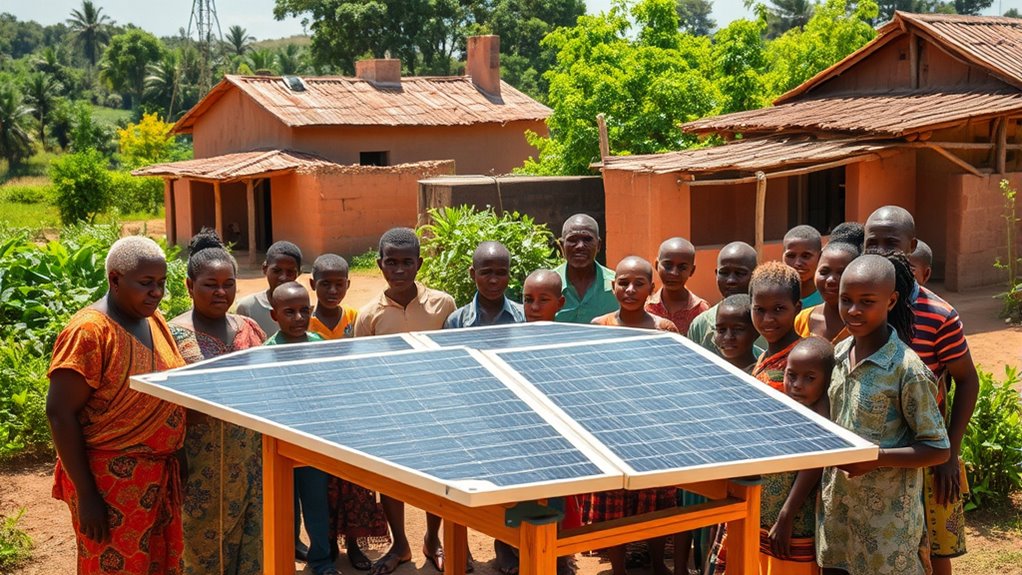
Renewables are transforming energy access across the developing world, offering a sustainable and cost-effective alternative to traditional fossil fuels. As communities seek reliable power sources, solar microgrids and wind energy stand out as practical solutions tailored to local needs. Solar microgrids, in particular, allow you to generate electricity close to where it’s consumed, reducing dependence on distant power stations and unreliable grid connections. By installing solar panels on rooftops or in communal areas, you can harness the sun’s energy during the day and store it for use at night or cloudy days. This decentralization empowers you to manage your energy needs more independently, decreasing costs and increasing resilience. Additionally, integrating storage solutions can further enhance the stability and reliability of renewable energy systems in your community. Wind energy, similarly, offers a versatile way to generate power in areas with consistent breezes. Small-scale wind turbines can be set up in rural or remote locations, providing a steady supply of electricity without the need for grid extension. When combined with solar microgrids, wind energy creates a hybrid system that maximizes renewable potential and ensures a more stable power supply. This means you can power essential services like clinics, schools, and small businesses, fostering economic growth and improving living standards. Both solar microgrids and wind energy are scalable, so whether you’re working on a small village project or a larger community initiative, these technologies can be adapted to fit your specific needs. The beauty of these renewable solutions is that they’re often easier and quicker to deploy than traditional infrastructure. You can install solar panels or wind turbines with less upfront investment and fewer logistical challenges, especially in remote areas where extending the grid is prohibitively expensive. Plus, the ongoing operational costs are minimal compared to fossil fuel alternatives, saving you money in the long run. As technology advances, the efficiency and affordability of solar microgrids and wind turbines continue to improve, making them even more accessible for communities like yours. Incorporating innovative technology integration strategies can further optimize system performance and user engagement. Recognizing the importance of project scalability can help you plan for future expansion as your community’s energy needs grow. Moreover, ongoing advancements in automation are making renewable energy systems more responsive and easier to manage remotely, enhancing overall system reliability. Implementing these solutions can also attract funding and partnerships, accelerating your community’s transition to clean energy.
Frequently Asked Questions
How Do Renewable Projects Impact Local Economies Long-Term?
You’ll find that renewable projects boost local economies long-term by fostering economic diversification and creating jobs. As these projects develop, they attract new industries and investments, reducing dependence on a single sector. You benefit from increased employment opportunities, which can lift incomes and improve living standards. Over time, these initiatives build resilient communities, ensuring sustainable growth and a more stable economic future for everyone involved.
What Are the Main Challenges Facing Renewable Adoption in Remote Areas?
You face several challenges when adopting renewables in remote areas. Technological barriers, like limited infrastructure and expertise, make installation and maintenance difficult. Cultural resistance can hinder acceptance, especially if communities distrust new technology or prefer traditional methods. Overcoming these issues requires tailored education, community engagement, and support to build trust and guarantee sustainable implementation. Addressing these obstacles is key to expanding renewable energy access in isolated regions.
How Do Community-Led Renewable Initiatives Succeed Over Government-Led Efforts?
Imagine 80% of rural communities thrive when they lead renewable projects themselves. You see, community-led initiatives succeed because they foster strong community engagement and leverage local innovation. When locals own the process, they’re more committed, adaptable, and culturally aligned, unlike top-down government efforts. Your active participation fuels trust and sustainability, ensuring renewable solutions meet real needs and are maintained long-term. That’s how grassroots power drives lasting change.
What Role Do International Organizations Play in Renewable Development?
International organizations play a pivotal role in renewable development by shaping policy frameworks that guide sustainable growth. They also provide essential funding mechanisms, enabling projects to move forward where local resources fall short. Your efforts benefit from their technical expertise, capacity building, and global networks, which help accelerate renewable adoption. By establishing clear policies and offering financial support, these organizations empower communities and governments to advance clean energy solutions effectively.
How Can Renewable Energy Be Made Affordable for Impoverished Communities?
Imagine a village where solar panels power homes, cutting costs and improving lives. You can make renewable energy affordable by focusing on cost reduction techniques and innovative financing models like microloans or pay-as-you-go systems. These approaches lower upfront expenses, making clean energy accessible. By adopting such models, impoverished communities gain reliable power, fostering development and resilience without financial strain.
Conclusion
By embracing renewables, you become a pioneer planting seeds of hope in the fertile soil of the developing world. These energy sources are the gentle rain nourishing communities, allowing them to blossom beyond darkness. As you empower local voices and ignite change, you forge a path where sustainable growth blooms like a resilient garden. Together, you’re transforming the landscape—turning fragile dreams into a vibrant, unstoppable forest of possibility and promise.
